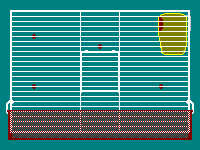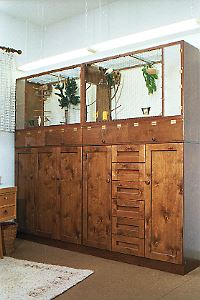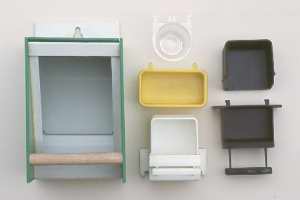 |
 |
What do you do if you unexpectedly come across such a small grass finch which may be anxiously sitting or fluttering in an old small budgie cage (or even cardboard box) and waiting for you to take care of it? Well, first of all you have to get hold of a cage, the larger, the better, and not round, but rectangular in shape. The bars must not be more than 12 mm (1/2") apart; the perches should be about 12 mm in diameter and fixed at both ends of the cage so as not to hinder them in flying.
First the cage should be cleaned carefully to prevent your Zebra Finch from getting infected with pathogens from the previous "owner". Next come a little sand and a food container open at the top: If the bird was bred in a large aviary it may well be that it does not know food containers with a lateral opening! As for water, a still insecure Zebra Finch does not really need it on the first day; if you do put a shallow water pan into the cage or hook a bathhouse onto its side, fill in only very little water: a frantically fluttering bird might get drowned in deep water!
The cage, thus prepared, should be placed in a quiet, light and draft-free place in your home: in a corner or with one long side against a wall, so that the new arrival doesn't feel endangered on all sides: Ready to welcome our guest – for the time being, because now you have to quickly get the bird(s) some food, i. e. on the same day (!), and on this occasion you should also buy a nest basket: Zebra Finches sleep in nests!
Zebra Finches are not suited to flying "free" in your home: they would dirty the curtain rails, shelves (and books on them), cupboards and cabinets, they might have an accident in the man-made surroundings, and eventually, when you have got used to their flying free, they would escape and perish – epecially in spring, when air is let in more frequently.
Therefore, they (and you) have to have proper accommodation, and this is not so easy to find: pet suppliers, geared to "marktet requirements", mostly offer small and cheap budgy cages in which a small bird can hop a bit, but not fly. There are expensive luxury models, too, of course, but these are generally not more spacious, but rather have all kinds of unnecessary frivolities like pagoda-like roofs and other ornaments which make the cage an adornment of the house but not a suitable home for birds.
So, buy the largest cage or mini-aviary for grass finches that the salesperson can show you: it should be at least one meter long and preferably much more. If you can get a box cage with a solid back wall, take it: it causes less dirt, and the birds feel much safer – epecially if they can look down on their keeper; to ensure this the mini aviary must be set up at eye level.
However, if you can afford an indoor aviary (built-in or mobile on wheels) you will reach the optimum in keeping Zebra Finches, which could only be enhanced by an outdoor aviary attached to it and accessible to the birds through a little window or door.
You'll find more details, also about the equipment with perches, sleeping und incubation nests, food and water containers and about temperature and humidity, light and lighting in the literature – e. g. in my Zebra Finch book at Barron's.

The basic equipment of an indoor aviary includes:
| Nutrition |